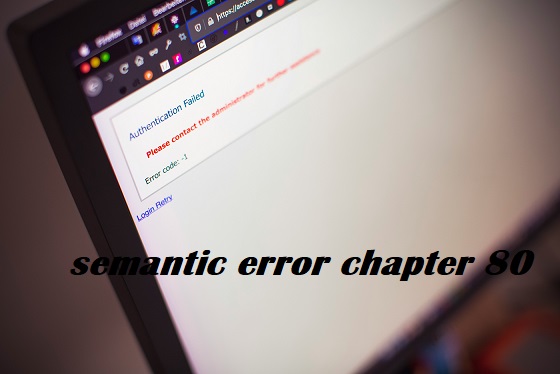
Semantic errors are a category of bugs that arise when an application does now not behave as meant, in spite of walking without crashes or syntax mistakes. These errors are regularly the hardest to detect because they stand up from logical mistakes in the code in preference to syntax or runtime problems. The discussion of “semantic error chapter 80” introduces this complex topic, aiming to prepare programmers to better understand, identify, and resolve these subtle yet impactful errors.
Definition and Overview
Semantic mistakes occur when the code’s logic does not align with the programmer’s intentions, mainly due to accurate code execution that produces incorrect results. These errors are not stuck at assemble-time because the code is syntactically correct. Understanding semantic errors entails recognizing that the program, whilst runnable, does now not do what it is meant to do in step with its practical necessities.
Importance in Programming
The impact of semantic errors in programming is profound as they can lead to significant functional discrepancies in applications. These errors affect the software’s quality and reliability, making them a critical focus area for developers. In the narrative of “semantic error chapter 80,” the importance of addressing these errors is underscored, highlighting their potential to cause unexpected behavior in software systems.
Understanding Semantic Errors
To manage semantic error chapter 80 effectively, programmers need to first understand their nature and origins. This knowledge helps in creating more robust debugging strategies and improves overall code quality.
Nature of Semantic Errors
The nature of semantic errors is deceptive; they hide within logically valid code. This makes them particularly challenging to detect because the code doesn’t crash or produce compiler errors. Programmers often encounter these errors only during specific conditions or data inputs that were not initially tested.
Common Causes of Semantic Errors
Semantic error chapter 80 can stem from various sources, including misunderstanding language features, incorrect algorithm implementation, or data type mismatches. Misconceptions about how particular functions work or how variables interact within the software can easily lead to these types of errors, necessitating thorough reviews and testing.
Identifying Semantic Errors
The identification of semantic errors is crucial for their resolution. Effective detection is based on a combination of systematic debugging, peer review, and automated testing.
Detection Techniques
Techniques to detect semantic errors include step-by-step code execution using debuggers, thorough code reviews, and automated static analysis tools. These tools help identify discrepancies between intended outcomes and actual software behavior.
Examples of Common Semantic Errors
Common examples include loops that never terminate, conditional statements that always evaluate to true or false, and operations on incompatible data types. Each instance can lead to programs that operate smoothly but fail to perform their intended functions correctly.
Strategies to Resolve Semantic Errors
Resolving semantic error chapter 80 requires a structured approach to debugging and testing. It also involves preventive measures through code reviews and feedback mechanisms.
Debugging Practices
Effective debugging practices for addressing semantic error chapter 80 include using breakpoints, examining variable states, and tracing function calls. These techniques help isolate the erroneous part of the code and facilitate its correction.
Code Review and Peer Feedback
Code reviews are essential in spotting potential semantic errors that the original developer might have overlooked. Peer feedback provides new insights and can help improve the overall design and logic of the code.
Unit Testing for Error Detection
Unit testing plays a pivotal role in detecting semantic error chapter 80 by checking individual components for correct behavior under various scenarios. Well-designed tests can catch errors before the code goes into production, reducing bugs and improving reliability.
Best Practices in Preventing Semantic Errors
Preventing semantic errors involves adherence to coding standards, proper documentation, and continuous learning.
Coding Standards and Documentation
Maintaining high coding standards and thorough documentation helps clarify the intended behavior of the code, reducing the likelihood of semantic misunderstandings. Standards and documentation serve as references that ensure consistency and correctness in implementation.
Regular Training and Workshops
Ongoing education and workshops on best programming practices and new technologies equip developers with the skills to avoid common semantic error chapter 80. They also foster an environment of continuous improvement and learning.
Future Trends in Semantic Error Management
Advancements in technology are set to transform how semantic errors are managed, with AI and machine learning leading the way.
Role of AI in Detecting and Resolving Semantic Errors
AI and systems getting to know algorithms are increasingly getting used to automate the detection and resolution of semantic errors. These technologies can examine huge quantities of code to find patterns and inconsistencies that may not be glaring to human reviewers.
Emerging Tools and Technologies
New debugging tools and technologies are being developed that specialize in detecting semantic errors more efficiently. These tools integrate advanced algorithms to provide deeper insights into the code’s behavior and its potential flaws.
Conclusion for semantic error chapter 80
In conclusion, “semantic error chapter 80” emphasizes the significance of understanding, identifying, and resolving semantic errors in programming. Mastery of these aspects is vital for growing exceptional, dependable software. By adhering to high-quality practices and leveraging emerging technology, developers can successfully manipulate and mitigate the impact of semantic mistakes.
Read more about The Ultimate Guide to Sales Pipeline Management.